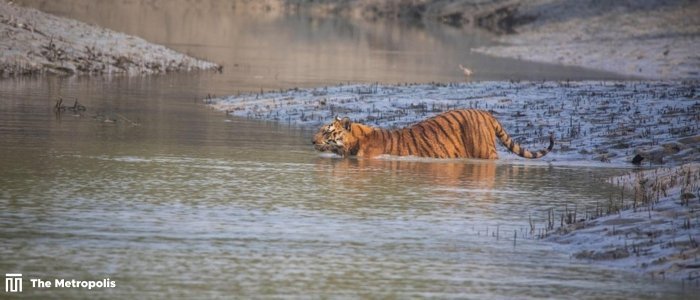Metropolis Desk-
The Third Pole has heard that officials are reevaluating a plan to reintroduce the big cat to the Chittagong Hill Tracts (CHT) as Bangladesh strives to enhance the number of endangered tigers in the nation.
The controversial plan, which gained media attention in 2020, called for the release of tigers in a remote region of Bangladesh’s south-east, close to the borders with India and Myanmar.
An assessment of the viability of reintroduction has discovered that the circumstances are not right at the moment. The Bangladesh Forest Department seems to have temporarily abandoned the proposal, even though there hasn’t been any formal notification to that effect, according to The Third Pole’s contacts with important officials.
Before releasing tigers in the CHT, two factors—habitat and prey—need to be taken into account, according to Md Amir Hossain Chowdhury, chief conservator of forests at Bangladesh’s Ministry of Environment, Forests, and Climate Change. “We have discovered that the habitat is unsuitable at the moment and that the hill tracts do not contain adequate prey for tigers. There, too, human settlements are a major issue. Therefore, we have abandoned our plan.
In the past, tigers were common in Bangladesh. They supposedly existed in 11 of the country’s 17 districts as recently as the 1930s. The Tiger Action Plan for 2018–2027, created by Bangladesh’s forest department as a guide for tiger recovery, notes that widespread poaching and forest depletion have decreased the tiger’s range and population.
The Sundarbans, the world’s biggest mangrove habitat created by the meeting of the Ganga, Brahmaputra, and Meghna rivers in the Bay of Bengal, is home to the sole resident tiger population in Bangladesh.
Chowdhury stated that the Chittagong hills “was the host of a huge number of tiger populations” in the past when he announced the government’s plans to reintroduce tigers to the region in 2020. The declaration was in line with the government’s Tiger Action Plan for 2018–2027, which ranked preserving a “viable tiger population in the Chittagong Hill Tracts” as a low-priority objective and specified that 100 million Bangladeshi taka (about USD 914,000) in funding would be needed over ten years. However, it appears that the idea has been postponed.
Threatened predator species have made a promising comeback in some parts of the world as a result of a mix of initiatives to lessen killing, rehabilitate ecosystems, and reintroduce the animals in regions where they had been exterminated. But for reintroduction operations to be successful, several intricate conditions must be in place, such as reducing risks to the reintroduced animals, sufficient prey, and the approval and cooperation of neighboring communities.
The Forest Department is presently attempting to regenerate the forests in the Chittagong Hill Tracts, according to Chowdhury, and once the restoration is complete, it will consider releasing tigers there.
A feasibility study was carried out in 2021 to gather “evidence of tigers [and their] habitat suitability, including the availability of prey species in the remote forest patches of the CHT,” according to Imran Ahmed, conservator of forests at the Bangladesh Forest Department. The Forest Department carried out the government-funded feasibility study project with technical support from IUCN Bangladesh.
According to the final report, which has not been made public, there is no conclusive proof that tigers are present in the Chittagong Hill Tracts. Despite reports that tigers were spotted crossing the Kasalong River, a significant stream that passes through the area, in 2021, this is the case.
The availability of prey species, preservation of genetic diversity, and the local population’s reaction to the idea of reintroducing tigers were among the factors taken into consideration in the study, according to a government official who shared the report’s key findings with The Third Pole but who asked to remain anonymous.
According to the findings, it is doubtful that any reintroduced tigers would survive until these conditions improve. The study’s findings were negative, according to Ahmed, and they do not now support efforts to restore tigers to the Chittagong Hill Tracts.
The vast, evergreen trees that make up the 1,645 square kilometer Kasalong Reserve Forest in the CHT are still mostly unaffected by human settlements and agricultural activity. Many creatures, including Asian elephants, two species of bears, three species of deer, leopards, and wild boars, live in the forest.
There has been ongoing discussion regarding the existence of some tigers for many years. Some experts thought the pugmarks (paw prints) made in the area in 2016 were made by tigers.
There is some evidence of tiger presence in the area, according to M Monirul H Khan, a tiger expert who worked on the CHT feasibility assessment. He explained, “We discovered remnants and a [tiger] head at a hunter’s hut during our journey to Kasalong Reserve Forest.
More scientific research is required, according to Ishtiaq Uddin Ahmed, a former chief conservator of forests at the Bangladesh Forest Department, to determine if pugmarks recorded in the Chittagong Hill Tracts are caused by local tigers or by tigers crossing the border from India and Myanmar.
Without a thorough assessment, he continued, “We will not be able to say [what] the actual status of tigers in the hill tracts is.”
The Third Pole quoted Bangladesh’s minister for the environment, forests, and climate change, Md Shabab Uddin, as saying: “Considering all the threats, we are not taking a decision right now to reintroduce tigers in the CHT but we have a plan to do so in the future.”
According to Uddin, the Bangladeshi government must first accomplish a different objective in its Tiger Action Plan, which is to “minimize poaching of tigers and prey, minimize habitat destruction, initiate habitat restoration, and establish connectivity between the fragmented habitats,” before making plans to relocate tigers from the Sundarbans to the Kasalong Forest Reserve in the CHT.
The minister informed The Third Pole that “the reintroduction of tigers in the Kasalong Reserve Forest will depend on the outcomes of the strategic action [plan] as well as the full support of the local tribal community.”
Source- The Third Pole




